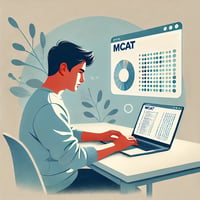Hi there! If you're working with a tight budget, investing in an expensive MCAT prep course might...
When to Use the AAMC Section Banks for MCAT Practice
The AAMC Section Banks are among the most challenging resources available for MCAT preparation. They’re designed to test your critical thinking and problem-solving skills, mimicking the complexity of the actual exam. However, knowing when to incorporate these questions into your study plan is crucial to maximizing their benefits. Here’s a guide to help you decide when to use the AAMC Section Banks in your MCAT prep.
Why Are the AAMC Section Banks Important?
The AAMC Section Banks are unique because they reflect the logic and question style you’ll encounter on the MCAT. Unlike many third-party practice materials, the Section Banks are crafted by the same organization that writes the actual MCAT, making them an invaluable resource for understanding the nuances of the test.
Key Features:
- Challenging Questions: The Section Banks are known for their difficulty, often featuring questions that are more challenging than those on the actual MCAT.
- Focus on Critical Reasoning: They emphasize the critical reasoning skills necessary for success on test day, especially in the CARS and science sections.
- Comprehensive Content Review: While not predictive of your final score, the Section Banks are excellent for content review, particularly in identifying weak areas.
When to Start Using the AAMC Section Banks
1. After Completing Content Review
A popular strategy is to use the AAMC Section Banks once you’ve completed the majority of your content review. At this stage, you should have a solid understanding of the material and be ready to apply that knowledge to complex, passage-based questions. The Section Banks can then serve as a tool to reinforce what you’ve learned and identify any lingering weak spots.
2. About a Month Before the Exam
Many students opt to start using the Section Banks about a month before their MCAT date. This timing allows you to solidify your understanding of AAMC’s logic and question style as you approach the exam. It’s close enough to test day that the practice will be fresh in your mind, but also leaves you time to review any weak areas that the Section Banks might reveal.
3. For Targeted Practice
If you’re particularly confident in your content knowledge, you might choose to use the Section Banks earlier in your study plan. This can be beneficial for honing in on specific areas where you struggle, as the detailed explanations in the Section Banks can deepen your understanding of difficult concepts.
Why You Might Want to Wait
1. Avoiding Burnout
Because the AAMC Section Banks are so challenging, starting them too early in your prep could lead to burnout. If you find the questions frustrating or demoralizing, it might be better to wait until you’re more confident in your abilities.
2. Maximizing Their Value
The Section Banks are a finite resource, and their value comes from their close alignment with the actual MCAT. Using them too early might mean you miss out on the full benefit of practicing with AAMC-style questions close to test day, when you’re better prepared to tackle their difficulty.
3. Using Other Resources First
Many students choose to start their prep with third-party resources like UWorld, Kaplan, or Princeton Review. These can be great for building foundational knowledge and test-taking skills. Once you’ve built up your confidence and mastered the basics, you can pivot to the AAMC Section Banks to fine-tune your skills.
Tips for Using the AAMC Section Banks Effectively
1. Don’t Stress Over Scores
The Section Banks are designed to be tough, and your percentage correct may be lower than on other practice materials. Instead of focusing on your score, use the Section Banks as a learning tool. Review each question thoroughly, paying attention to the reasoning behind the correct answers.
2. Use Them Twice
Some students find it helpful to go through the Section Banks more than once. If you do this, be sure to leave some time between attempts so that you’re not simply memorizing the answers. This approach can help reinforce difficult concepts and ensure you’ve truly mastered the material.
3. Incorporate Timing Practice
To simulate test conditions, consider timing yourself when you work through the Section Banks. This can help you build the pacing skills necessary for the actual MCAT, especially when working on full-length sections.
Final Thoughts
The AAMC Section Banks are an essential part of any MCAT study plan, but timing is key to getting the most out of them. Whether you choose to use them closer to test day or earlier in your preparation, the Section Banks will challenge you and help you fine-tune your skills. Remember, the goal is not to achieve a perfect score on these difficult questions, but to deepen your understanding of the material and get comfortable with AAMC’s testing style.
Ultimately, the best approach is the one that works for you. Whether you start early or wait until a month before the exam, the AAMC Section Banks will be a valuable tool in your journey to MCAT success.



